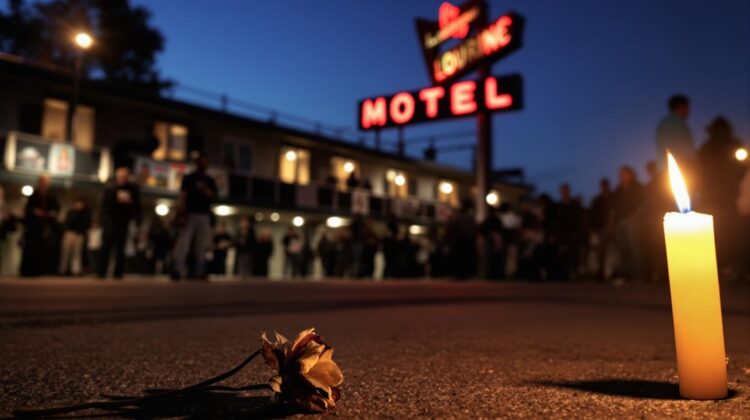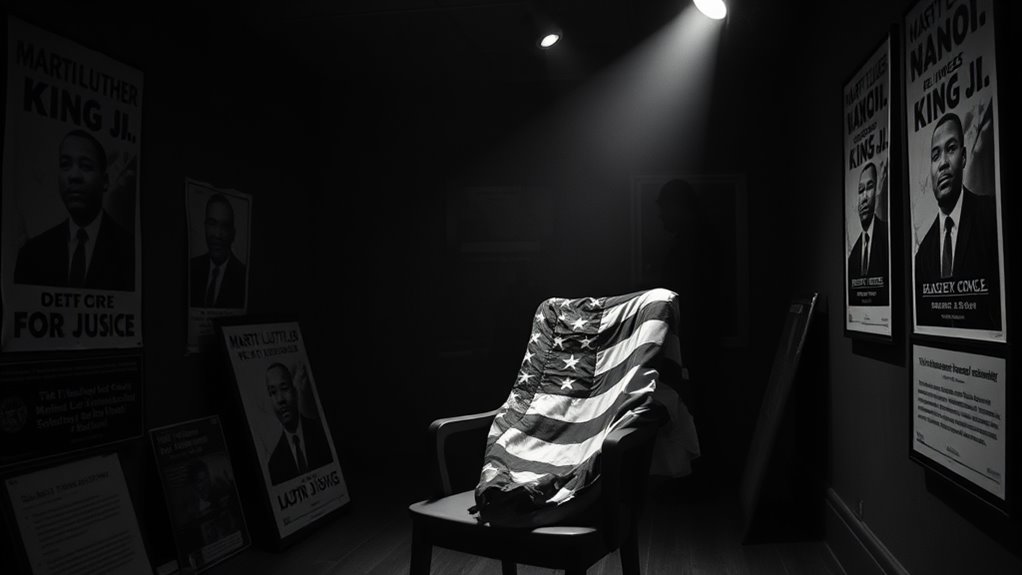
Martin Luther King Jr. was assassinated on April 4, 1968, by James Earl Ray, whose actions shocked the nation and galvanized the civil rights movement. King's death sparked widespread protests and highlighted ongoing racial injustice in America. The aftermath raised questions about the FBI's investigation, conspiracy theories, and the need for accountability. King's legacy continues to inspire discussions on racial equality and justice today, revealing the enduring relevance of his message in contemporary society. There's much more to explore about this critical chapter in history.
Table Of Contents
Article Highlights
- Martin Luther King Jr. was assassinated by James Earl Ray on April 4, 1968, with ongoing debates about potential conspiracies surrounding his death.
- The FBI's investigation into King's assassination faced public scrutiny, raising questions about its thoroughness and possible governmental involvement.
- The assassination sparked widespread riots and protests, highlighting the deep-rooted anger over racial injustice in America.
- King's legacy continues to inspire movements for racial equality, including Black Lives Matter, demonstrating the ongoing relevance of his message.
- The King family's belief that Ray did not act alone fosters distrust in official narratives, emphasizing the importance of addressing historical injustices.
Background of Martin Luther King Jr.'s Activism

Though he faced significant challenges, Martin Luther King Jr. emerged as a pivotal figure in the civil rights movement during the 1950s and 1960s, championing nonviolent resistance against racial injustice. His activism began to take shape during the Montgomery Bus Boycott, where he played an essential role in challenging segregation and drawing national attention. As a leader of the Southern Christian Leadership Conference, King organized impactful events like the Birmingham Campaign and the March on Washington, where he delivered his iconic "I Have a Dream" speech. His advocacy for nonviolent resistance earned him the Nobel Peace Prize in 1964, solidifying his influence. King's tireless efforts laid the foundation for landmark legislation, including the Civil Rights Act of 1964 and the Voting Rights Act of 1965.
The Assassination on April 4, 1968
On April 4, 1968, the civil rights movement faced an unimaginable tragedy when Martin Luther King Jr. was assassinated at 6:01 p.m. As he stood on the balcony of the Lorraine Motel in Memphis, Tennessee, he was shot by a sniper using a Remington 760 Gamemaster .30-06 rifle, with the fatal shot striking him in the neck. In spite of being rushed to St. Joseph's Hospital, King was pronounced dead at 7:05 p.m., just over an hour after the shooting. The primary suspect, James Earl Ray, was identified shortly after and later convicted of first-degree murder, receiving a 99-year prison sentence. King's assassination profoundly impacted the civil rights movement, catalyzing further mobilization in the fight for racial equality in the United States.
Immediate Responses to King's Death

As news of Martin Luther King Jr.'s assassination spread, it ignited a wave of shock and outrage across the nation. The impact was immediate and profound, prompting responses that reflected the deep grief and anger felt by many.
- Widespread riots erupted in over 100 cities.
- Activism for racial equality intensified.
- The federal government identified James Earl Ray as the prime suspect.
- King's death served as a catalyst for the civil rights movement.
Within hours, King was pronounced dead at St. Joseph's Hospital, intensifying the emotions surrounding the tragedy. The aftermath of his assassination marked a significant turning point, as communities grappled with their loss as they rallied for justice and equality, forever altering the course of the civil rights movement.
The Role of the FBI in Investigating the Assassination
In the wake of Martin Luther King Jr.'s assassination, the FBI swiftly identified James Earl Ray as the prime suspect and launched an extensive investigation into his background and activities. The agency had been surveilling King since 1963, raising suspicions about potential conspiracy involvement. Regardless of the House Select Committee's 1979 conclusion that Ray acted alone, skepticism persists regarding the FBI's findings and the thoroughness of their investigation.
| Evidence Collected | Key Findings | Public Perception |
|---|---|---|
| Fingerprints on rifle | Linked to James Earl Ray | Doubts about investigation |
| Surveillance records | Possible conspiracy theories | Accusations of FBI harassment |
| Eyewitness testimonies | Conflicting accounts | Calls for transparency |
Coretta Scott King and others have criticized the FBI's tactics, deepening questions about the agency's role.
The Capture and Legal Proceedings of James Earl Ray

James Earl Ray was arrested at Heathrow Airport on June 8, 1968, as he attempted to escape to England with a fake passport. He pleaded guilty to Martin Luther King Jr.'s murder in March 1969, which meant he waived his right to a trial. Nevertheless, just months later, Ray recanted his confession, claiming he was framed and suggesting the involvement of a mysterious figure named Raoul.
Arrest at Heathrow Airport
After evading capture for weeks, James Earl Ray was arrested on June 8, 1968, at Heathrow Airport as he was trying to flee to Canada with a fake passport. His capture marked a significant turning point in the investigation into the assassination of Martin Luther King Jr. Ray's extradition back to the United States quickly followed, where he faced serious charges.
Key details about Ray's arrest include:
- Attempting to escape using a false identity
- Immediate extradition to the U.S.
- Connection to the murder of King
- Claims of a conspiracy to kill King
Despite pleading guilty and receiving a 100-year sentence, Ray later recanted, alleging he was set up by a man named Raoul, hinting at deeper conspiracies.
Guilty Plea Details
Although Ray was apprehended in June 1968, it wasn't until March 10, 1969, that he pleaded guilty to the murder of Martin Luther King Jr., a decision that effectively waived his right to a trial. His guilty plea resulted in a 99-year prison sentence, sealing his fate in the public eye. Shortly after, Ray recanted, claiming he was set up by a mysterious figure named "Raoul." In spite of his assertions, federal investigations found insufficient evidence to support his conspiracy claims. In a twist of events, Ray escaped from Brushy Mountain Prison in June 1977 but was recaptured after just 54 hours, raising doubts about whether he acted alone in orchestrating the assassination and its aftermath.
Recanting Confession Claims
Although Ray initially accepted responsibility for the assassination, he quickly recanted his confession, alleging that he was framed by a mysterious figure named Raoul. This recantation raised numerous questions about the legitimacy of his guilty plea and the concept of conspiracy surrounding the assassination.
- Ray struggled to provide coherent evidence for his claims.
- Federal investigations found no proof of Raoul's existence.
- Ray's fingerprints were the only ones on the murder weapon.
- Civil rights leaders and the King family pushed for a trial to investigate conspiracy claims.
Despite the absence of corroborating evidence, the controversy surrounding Ray's case endures, highlighting the intricacies of justice and accountability in one of America's most significant historical events.
Conspiracy Theories Surrounding King's Assassination
As questions linger about Martin Luther King Jr.'s assassination, various conspiracy theories have emerged suggesting more than just James Earl Ray's involvement. Some theorists point to possible government complicity, whereas others speculate about connections to organized crime or alternative suspects. In spite of official findings, skepticism persists, fueling ongoing debates about the true circumstances surrounding King's death.
Theories of Government Involvement
Although James Earl Ray was convicted for the assassination of Martin Luther King Jr., many believe a broader conspiracy involving government agencies and organized crime played an essential role in the events leading to his death.
Key elements fueling these theories include:
- Coretta Scott King and her children asserting Ray wasn't the sole perpetrator.
- A 1999 civil suit where a jury found government entities liable for conspiracy.
- Loyd Jowers' claims of a conspiracy involving a police officer.
- William Pepper's theories suggesting Ray was merely a scapegoat.
These claims raise significant questions about the true nature of King's assassination, highlighting a distrust in official narratives and suggesting a complex interplay of motivations behind the tragic event.
Organized Crime Connections
Although many details surrounding Martin Luther King Jr.'s assassination remain murky, connections to organized crime continue to fuel conspiracy theories. The King family has suggested that both organized crime and government entities may have collaborated in a high-level conspiracy. Loyd Jowers claimed to be part of this conspiracy, alleging police involvement, which led to a civil trial. Coretta Scott King likewise believed a conspiracy was at play, given the FBI's harassment of her husband. Whereas the House Select Committee on Assassinations found no definitive link between organized crime and the assassination, investigations raised questions about James Earl Ray's ability to act alone, keeping speculation alive.
| Evidence of Conspiracy | Key Figures Involved |
|---|---|
| Loyd Jowers' Claims | Martin Luther King Jr. |
| Coretta Scott King's Beliefs | James Earl Ray |
| House Select Committee's Findings | Organized Crime Entities |
Alternative Suspects Considered
Despite James Earl Ray is officially recognized as Martin Luther King Jr.'s assassin, numerous alternative suspects have emerged in conspiracy theories that question the official narrative. The King family, especially Coretta Scott King, has long believed that multiple parties were involved in the conspiracy to kill King. Some key points include:
- Loyd Jowers claimed involvement in a conspiracy in the 1990s.
- The House Select Committee suggested a possible conspiracy but lacked definitive evidence.
- Civil rights leaders like Rep. John Lewis expressed skepticism about Ray acting alone.
- Investigations faced criticism for not adequately addressing conspiracy claims.
These elements fuel ongoing debates around King's assassination and the implications of a deeper conspiracy beyond James Earl Ray.
The King Family's Advocacy for Justice
The King family's relentless pursuit of justice surrounding Martin Luther King Jr.'s assassination underscores their belief that James Earl Ray did not act alone. They argue that a broader conspiracy involving various entities, including organized crime and government agencies, played a role in the tragic event. In 1999, the King family filed a civil suit against local, state, and federal governments, leading to a jury ruling that found evidence of conspiracy. Coretta Scott King, until her death, highlighted substantial evidence supporting this theory. Dexter King even visited Ray in prison, seeking the truth. Bernice King has voiced that the true identity of the murderer remains unknown, emphasizing the need for accountability and justice in her father's case.
Impact on the Civil Rights Movement
Martin Luther King Jr.'s assassination didn't just leave a void; it ignited a fire within the civil rights movement that reshaped its trajectory. The immediate aftermath saw widespread protests and riots, reflecting deep-rooted anger and frustration over racial injustice. The King family's advocacy for truth further fueled discussions about potential conspiracy theories surrounding his death, emphasizing the need for justice.
Key impacts included:
- Mobilization of protests in over 100 cities
- Passage of the Fair Housing Act of 1968
- Continued evolution of the civil rights movement
- Annual observances honoring King's legacy
King's death, during a tragedy, became a catalyst, inspiring new generations to push for racial equality and reminding society of the ongoing struggle for justice.
Ongoing Discussions About Racial Equality
As discussions about racial equality persist, they often reflect the enduring influence of Martin Luther King Jr.'s vision and the intricacies of systemic injustice. The assassination of King in 1968 ignited a firestorm of protests and conversations about civil rights, shaping the terrain of activism today. His legacy is a catalyst for movements like Black Lives Matter, which continue to address historical injustices faced by African Americans. In addition, the King family's claims of a conspiracy surrounding his death have deepened distrust in official narratives, fueling ongoing debates about accountability within government institutions. These conversations underscore the importance of acknowledging past and present injustices as society endeavors for true racial equality, highlighting that the struggle for justice remains as critical as ever.
Legacy and Commemoration of Martin Luther King Jr
Remembering Martin Luther King Jr. evokes a profound sense of justice and hope, reflecting his enduring impact on civil rights and equality. His legacy is commemorated through various observances and memorials, ensuring his contributions remain relevant.
- The Lorraine Motel, site of his assassination, serves as a poignant memorial.
- Annual wreath-laying ceremonies honor his commitment to racial equality.
- Events highlight ongoing discussions about social justice and the implications of his legacy.
- The King family advocates for truth regarding his assassination and its effects on civil rights.
These commemorative events not only celebrate King's vision for a more equitable society but also inspire continued activism, reminding everyone of the persistent struggle against racial injustice.
Frequently Asked Questions
How Did King's Death Impact the Fight for Equality?
King's death profoundly impacted the fight for equality, fueling a surge in civil rights activism. His assassination galvanized communities, leading to widespread protests and a renewed commitment to social justice. The legacy impact of his work inspired significant legislative changes, like the Fair Housing Act of 1968, aimed at dismantling racial discrimination. Even today, his message continues to resonate, motivating movements that endeavor for equality and justice in society.
Is James Earl Ray Still Alive?
In the shadows of history, whispers linger about James Earl Ray's fate. He's not alive; he passed away on April 23, 1998, after years spent maneuvering the confines of prison life. Regardless of his demise, conspiracy theories surrounding his involvement in Martin Luther King Jr.'s assassination continue to swirl like autumn leaves caught in a restless wind. Ray's claims of innocence left many questioning the truth, igniting debates that refuse to die.
Who Tried to Stop Martin Luther King, Jr.?
Throughout Martin Luther King Jr.'s life, numerous entities tried to stop him because of his civil rights activism. The FBI, driven by fears of his influence, surveilled him relentlessly, believing he posed a threat to national security. In this historical context, assassination motives included a desire to silence a significant voice advocating for change. Some civil rights leaders likewise suspected a broader conspiracy aimed at undermining King's impact on society.
What Were James Earl Ray's Last Words?
James Earl Ray's last words reflected his long-standing motivations and beliefs about his innocence. In his final confession, he insisted, "I didn't do it," and claimed he'd been framed, suggesting a conspiracy behind the assassination. This assertion raised numerous legacy questions regarding his role and the possibility of a broader plot. In spite of the controversy surrounding him, Ray's claims lacked substantial evidence, leaving a lingering ambiguity in the historical narrative.

Leave a Reply